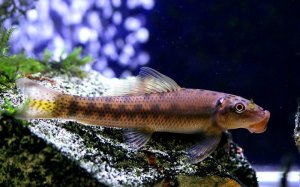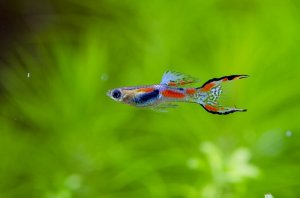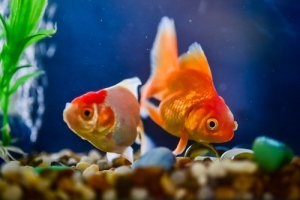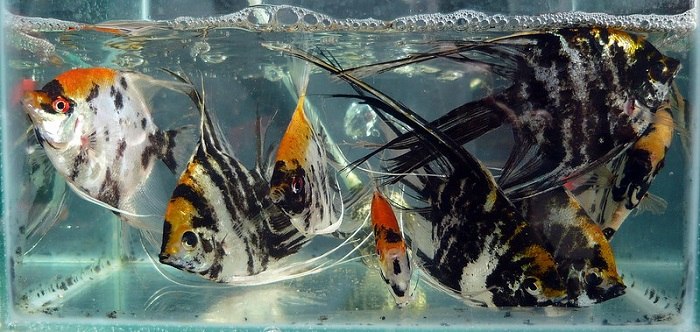
Angelfish are impressive and majestic fish that come from the Amazon, Orinoco, and other South American rivers. On seeing them you would be mistaken for thinking they are much larger than they actually are, especially with their tall and trailing fins.
When you encounter them in an aquatics store, these fish are initially quite small. However, they do indeed eventually grow to a large size. So, if you’re hoping to create a habitat that they can grow into, and that will last for a while, read on.
How Many Angelfish In A 55-Gallon Tank?
Common Myths About Angelfish Tank Size
Angelfish are cichlids and this can lead some people to believe that they are similar to other cichlids like the Oscar fish, which is much bigger, stronger, more active, and predatory. Although Angelfish do share some qualities with other cichlids, they are smaller and relatively – keyword relatively! – peaceful.
Nevertheless, they still need a large enough tank.
Another misconception is that because Angelfish are semi-aggressive, they need to be kept alone. This couldn’t be further from the truth! Even though they establish a hierarchy and pecking order, this social information is actually vital to them feeling safe as they sustain a lot of their well-being from the group dynamics. Yes, hierarchies occur, but they also need the closeness of the group to feel safe as this is how they live in the wild.
Angelfish Tank Size Dos And Don’ts
- DO use a tank that is longer (wider) than it is tall
- DON’T use a rounded tank
- DO use lots of decorations, driftwood, and plants to ensure a variety of habitats
- DON’T forget to add a substrate
- DO opt for a tank slightly on the larger side if in doubt
- DON’T expect your Angelfish to coexist in a small space
Are Angelfish Schooling Fish?
Angelfish are group fish and do often hang out in a shoal, but they are not schooling fish in the way Danios, or Tetras are. Schooling refers to all fish swimming in unison in the same direction. Shoaling is a much looser term and refers to when fish swim together. Angelfish really need this social group. However, depending on the shape of your tank, you may also see them swimming in a line.
How Many Angelfish Can You Put In A 55-Gallon Tank?
The most basic answer to this question is that the maximum number of angel fish for a 55-gallon (250 liters) tank is 6. This is a healthy group number although it is a little on the higher side for a tank of this size. Angelfish do need plenty of room to establish a pecking order and nevertheless feel confident in their own territories.
The minimum number for a tank of this size and for an Angelfish tank, in general, is about 4. If lower, the lowest-ranking fish in the hierarchy can get picked on too much. In addition, the fish do not get enough social information, and they may be understimulated. Don’t be tempted to reduce your number of fish just because you want a smaller tank. 5 is always a happy medium number. You can in turn raise the tank size to 60 or 65 gallons if you want a group of 6 to really thrive.
How Do You Set Up An Angelfish Tank?
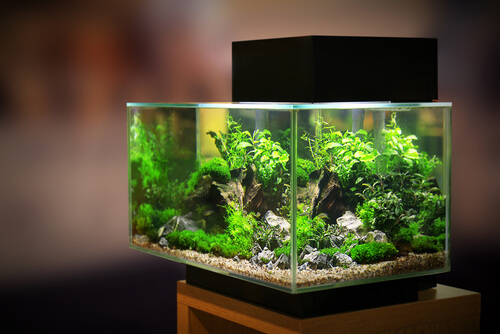
Now you’ve chosen your group size, it’s time to set up an Angelfish tank. Essentially you need to allow plants and other parts of the habitat to establish first. Angelfish come from soft, acidic waters that are rich in nutrients and thus they don’t do well in a barren tank.
Instead, using specialist aquatic soil and planting this with live plants before covering it with your substrate of choice will allow these plants to establish and contribute to the microscopic tank ecosystem. They also do best at a temperature of roughly 76 to 82 F (25-28 C).
You may also wish to add some tank mates. If so, you can increase the tank size to around 65 gallons (295 liters) or 75 gallons (340 liters) if you want to add a small school of Tetras, Rasboras, or other tankmates. In general with these small fish, one gallon per fish is a good rule of thumb. Alternatively, for larger tankmates, you can calculate the minimum tank capacity for them and factor this into your initial tank setup.
What Is The Smallest Tank Size For Angelfish?
The absolute minimum size for an Angelfish tank would be around 50 gallons (227 liters) for a group of four, although this is not recommended, it is merely doable. It is always better to opt for a richer, more stimulating environment.
Having a smaller tank can be detrimental to lower-ranking Angelfish. Science has found that subordinate members, when environmental conditions are stressed, tend to feed less than higher-ranking members. So, if you want all your fish to be well-fed, ensure you have a spacious tank and rich environment for them.
How Does Angelfish Social Hierarchy Work?
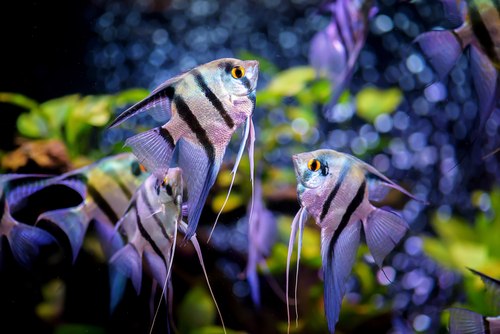
Caring for Angelfish is impossible without understanding their social hierarchy. Angelfish choose their positions in the hierarchy based on factors like strength, speed, and size. In addition, it’s important for them to understand the hierarchy and their place in it. Subordinate fish, for example, tend to spend more time in the company of subordinates.
However, even though this may sound unpleasant, consequences only break out in overcrowded and poor water conditions. This can look like Angelfish fighting, nipping fins, and chasing each other.
How do you tell this from healthy hierarchical behavior? You will notice that in a tank that has enough space and in which all fish are confident, chasing behavior rarely escalates. Instead, it will be in response to distinct stimuli such as fish pushing others out of the way to get food to establish themselves in the hierarchy.
Simply add more food to a different part of the tank to ensure all fish get fed. You will also see fish establish territories, for example, Angelfish are very individual fish and you may see one preferring to be near a particular set of plants. So long as there is no excessive chasing, your fish will be fine with a small amount of hierarchical behavior.
How Do You Acclimatize Angelfish To Their New Tank?
After you have established the tank and let the filter run for a few wells or even up to a month to allow bacteria to colonize the filter, you can add your fish.
You will most likely bring them home in a plastic bag, so all you need to do is float this on the top of the tank until the water temperature inside and outside the bag is the same – this part normally takes about an hour.
Then, you can allow your fish to swim out of the bag by opening it and creating a big enough gap.
This is much gentler on your fish than opening the bag and pouring them in. It is imperative that you do not allow your fish to feel a temperature shock or receive too much stress – fish can actually die from this.
After all your fish have swum out, remove the plastic bag.
- Overcrowding And Disease
One reason it’s important to prevent overcrowding is because it stresses the fish. This can in turn make them more susceptible to disease. Stress can be both behavioral and physical but studies have found across a variety of species that this makes fish more vulnerable to a whole host of diseases.
How Can I Tell My Angelfish Have Formed A Stable Group?
Apart from hierarchical behavior, how can you tell that your fish are happy, confident, and have formed a stable group?
One of the best signs to look out for is that they are swimming after each other. You will often see Angelfish swimming in a line or drifting in a group between plants, driftwood, and other tank decorations. This shows they feel calm and at ease. However, social hierarchy can change, especially after significant environmental changes such as movement to a new tank.
In addition, observe your fish’s behavior at feeding time. If there is minimal competition for food, rest assured that the group is settled in. Some competition can be natural, but too much, and it may be that your fish have not yet acclimatized themselves, or you have a bullying issue on your hands…
How Many Angelfish In A 75-Gallon Tank?
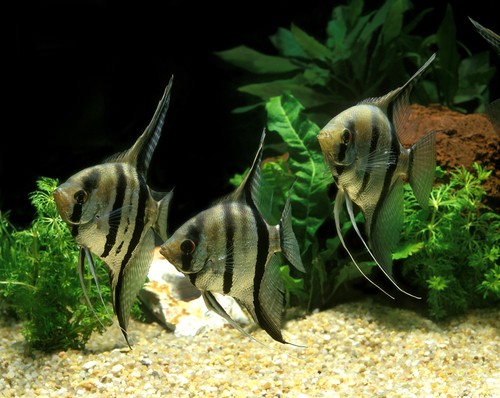
Although this may seem like quite a large increase in tank capacity compared to a minimal 55-gallon tank, it’s always better to space fish out. Thus the ideal number of Angelfish for this tank is from 6-7, which may not seem like an increase of that much. However, bear in mind that whenever you add an extra Angelfish, you will be making the tank hierarchy more complicated.
Therefore, the greater the ratio of space to fish, the better. This means hierarchical disputes are less likely to break out, and fish are able to establish a harmonious equilibrium.
Can Angelfish Live In A Larger Community Tank?
Angelfish can indeed live in a larger community tank, but it depends on what else you are housing in that tank. Angelfish come from the Amazon, so an Amazonian ecosystem is a good community tank to create with a variety of other Amazonian fish. These can include small Tetras but may also include Pleco Fish if you want to add an Algae Eater to your tank.
With both these fish, you will have to calculate the extra water needed based on the needs of the other fish. For example, add an extra 30 gallons (114 liters) if you plan to keep a pleco, as pleco fish need to live in a tank that is a minimum of 30 gallons.
However, did you know Angelfish can happily coexist with Discus Fish? Angelfish and Discus Fish are both types of cichlid. Discus fish are known for being peaceful, timid, and sensitive, whilst Angelfish are known for being semi-aggressive. So how can the two possibly coexist?
Fortunately, this is possible, but only in a large enough tank. When they have sufficient space and plenty of different habitats within the tank, you will find both types of fish keep themselves to themselves. That’s why it’s not only possible to keep the two together, but is actually a very logical pairing if you want a large Amazonian ecosystem.
Likewise, you can keep some smaller Amazonian cichlids with them such as the Electric Blue Ram Cichlid. The fish that it’s best to avoid are larger predatory Cichlids like the Oscar and Jack Dempsey. These can easily bully, harass, and even feed on your Angelfish.
How Many Angelfish Should Be Kept Together For Breeding Purposes?
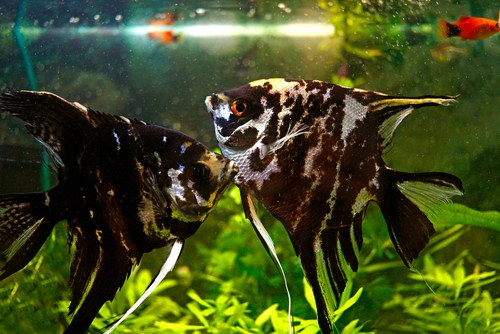
It’s very hard to tell the sex of Angelfish, so when you wish to breed them it’s likely you may want to put a group together. The truth of this is that it depends on the size of your breeding tank. However, this also depends on how many successful pairs you wish to encourage.
Fish in general can have a huge number of fry at any one time, so if you include too many fish in your breeding tank, you may end up with more fry on your hands than you expected. That’s why most Angelfish breeders include anything from 4 to 6 fish in their breeding tank in the hopes of finding a matching pair.
Can Male And Female Angelfish Coexist?
The short answer to this is yes. Not only can male and female Angelfish coexist, but generally most Angelfish tanks will have a mixture of both due to how difficult it is to sex Angelfish. You will probably find that you cannot tell at first which are male and which are female.
Therefore, you end up keeping a mixture of males and females together. An unexpected side effect of this is that you may eventually see pairs form. You can spot courting Angelfish, in fact, by the fact they will be locking lips and chasing each other.
Bottom Line
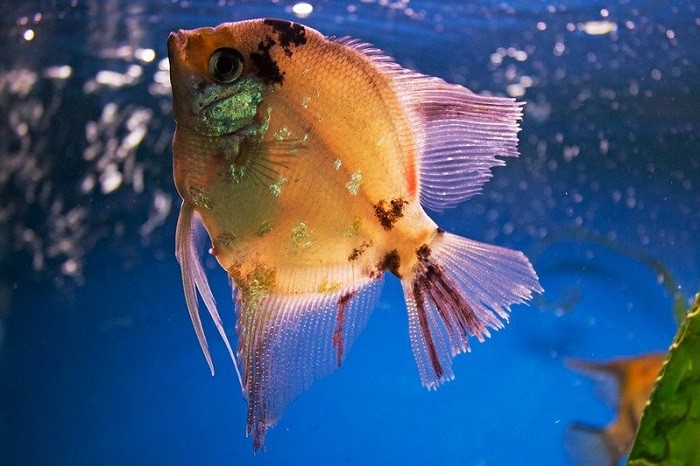
Building and establishing a successful community tank is about much more than just the specific tried and tested quantities of fish, although these are important. Instead, it is about understanding all your fish’s unique needs and environments as well as how they interact so your Angelfish can live successfully together – and with other tankmates.


